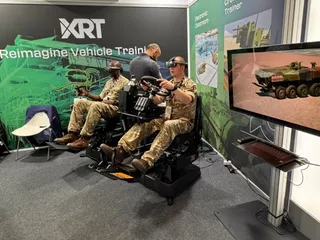APATS 2025: Behavioral Changes in UPRT Training
Contact Our Team
For more information about how Halldale can add value to your marketing and promotional campaigns or to discuss event exhibitor and sponsorship opportunities, contact our team to find out more
The Americas -
holly.foster@halldale.com
Rest of World -
jeremy@halldale.com

Key Takeaways
- Loss-of-control accidents remain the leading cause of aviation fatalities, with Australian general aviation seeing approximately one fatality per week.
- UPRT must address three phases: awareness (environmental factors), prevention (decision-making and startle control), and recovery (aerodynamic skills)
- Individual physiological responses vary significantly, requiring personalized training approaches rather than one-size-fits-all programs.
- Research has shown that decreased frustration and improved stress recovery occur as pilots progress through multi-day training.
- Heart rate variability monitoring revealed improved regulation of the sympathetic nervous system and faster recovery of the parasympathetic nervous system.
- Exposure alone doesn't build resilience—intensive, multi-day training with repetition is crucial for developing neural pathways.
At the Asia Pacific Aviation Training Summit (APATS) 2025 in Singapore, Shane Tobin, CEO/Director of UPRT Australia, presented compelling research on how personalized Upset Prevention and Recovery Training (UPRT) creates measurable behavioral and physiological changes in pilots. His findings challenge traditional training approaches and demonstrate the critical importance of understanding individual stress responses.
Want to explore more pressing discussions on pilot training? Join us at EATS this November and learn more here.
The Persistent Loss of Control Challenge
Despite industry advances, loss of control in flight remains aviation's deadliest threat. "In Australian general aviation alone, we have seen around 900 fatalities in the last 20 years. So that's, on average, about one a week," Tobin reported. The recent VO Pass ATR accident
in August 2024, which killed 62 people when the aircraft entered a flat spin after encountering icing conditions, underscores the ongoing urgency of this issue.
The problem extends beyond technical knowledge. "We cannot train UPRT just as a recovery training process. We've got to look at how we escalate, or how the human body escalates the event within our head and within our body, our psychophysiological response," Tobin emphasized.
A Three-Phase Approach to UPRT
UPRT Australia developed a comprehensive framework addressing loss of control across three critical phases:
Awareness focuses on environmental factors, knowledge of aircraft systems, and understanding how pilot mismanagement can escalate situations beyond recovery.
Prevention emphasizes competencies including decision-making, risk management, situational awareness, and controlling startle and surprise responses. "We must first understand that we are fallible. We are humans, and we are going to make some potential errors, and being able to bounce back from that intervention," Tobin noted.
Recovery addresses aircraft upsets and energy state awareness, recognizing that "it's not the environmental factor that actually caused the aircraft to crash in general, it's the pilot's inappropriate response after the aircraft departed controlled flight."
Personalized Training Philosophy
Unlike standardized programs, UPRT Australia's approach recognizes individual differences. "The way that we've designed our UPRT programs is not a one-size-fits-all. It is very much bespoke around what the requirements are of the client and also the experience base of the instructors and the trainees," Tobin explained.
This philosophy extends to physiological responses: "We've got to understand that each individual is different, and so how we train that for a particular individual must take that individual's reaction into account."
Groundbreaking Research Methodology
To validate their approach, UPRT Australia partnered with Griffith University for a proof-of-concept study involving pilots with 60 to 600 hours of flight experience. The comprehensive research protocol included:
- Pre and post-flight questionnaires measuring anxiety and workload
- Continuous physiological monitoring using Hexoskin vests
- Eye tracking technology (with mixed results due to G-force and glare issues)
- Video recordings from multiple angles
- State-Trait Anxiety Index assessments
- NASA Task Load Index evaluations
The three-day course consisted of four flights and 12-14 hours of academic instruction, covering aerodynamics, non-technical skills, and psychophysiological responses.
Measurable Stress Response Changes
The research revealed significant improvements in pilot stress management. Using the State-Trait Anxiety Index, researchers found "significant changes in content, relaxed, tense, and worried between each pre-flight and post-flight test." Crucially, while pilots experienced appropriate stress responses to new challenges, their overall resilience improved throughout the course.
NASA Task Load Index results revealed notable patterns. "We saw an increase in physical demand. This made sense, and actually verifies that the type of training that we're doing is working," Tobin explained. However, pilots also experienced "a significant decrease in frustration, a significant decrease in irritability and a significant decrease in discouragement."
The research identified a consistent spike in mental demand during the third flight, when pilots first encountered nose-low, over-bank recoveries—"the first time they're looking at the ground upside down."
Physiological Validation Through Heart Rate Monitoring
The Hexoskin vest technology provided an objective measurement of autonomic nervous system responses through heart rate variability analysis. This system detected "the allostatic load, which is the precursor ramp up to the activation of the sympathetic nervous system," allowing researchers to observe stress responses in real-time.
Results showed "an increase in the activation of the sympathetic nervous system as the flights went along, based upon how the flights started to escalate in nature. But what we also saw was a quick come down off the sympathetic nervous system and stress spike, and a better and more responsive activation of the parasympathetic nervous system."
This data provided crucial validation that the training's stress management techniques were effective in real-world applications.
Beyond Aircraft Control: Building Life Skills
The training's benefits extended beyond aviation scenarios. Tobin shared that "we had one of our trainees who recently had a near mid-air collision in the circuit, and they applied the initial psychophysiological responses that we embedded in them, and they said it actually saved their life and allowed them to take evasive action."
This demonstrates the broader applicability of psychophysiological training for any high-stress situation, not just aircraft upsets.
Critical Training Design Principles
The research reinforced several key principles for effective UPRT:
Exposure Doesn't Equal Resilience: "You can't just take someone upside down, give them some aerobatics... and expect them to be able to recover the airplane. We've got to improve their knowledge."
Intensive Immersion Required: "You have to get in the pool to learn how to swim. You can't just sit on the side of the pool and practice your backstroke."
Multi-Day Programs Essential: Initially offering two-day courses, UPRT Australia found significant improvement when extending to three days, allowing "extra time given to rewrite the neural pathways."
Early Implementation Crucial: "The law of primacy is important. The earlier we can get in and do this type of training, the better the outcome is going to be and the better the transferability."
Future Research Directions
While eye tracking technology faced challenges in the flight environment due to G-forces and sun glare, the research team plans to expand their study with larger datasets and improved technology. The video recordings successfully demonstrated improvements in metacognition — pilots are "starting to look in the right place to get the right information to affect the correct recovery."
Implications for Industry Training
This research provides compelling evidence that effective UPRT must address both technical skills and human factors. The measurable improvements in stress management, combined with enhanced aerodynamic recovery skills, suggest that comprehensive, personalized training programs can have a significant impact on pilot safety and performance.
The findings challenge traditional approaches that focus solely on procedural training, demonstrating instead that understanding and training individual psychophysiological responses is essential for developing truly resilient pilots capable of handling high-stress situations both in aviation and beyond.
As loss-of-control accidents continue to claim lives, this research offers a data-driven path forward for more effective training that acknowledges the critical role of human factors in aviation safety.
The conversation on pilot training will continue at the European Aviation Training Summit (EATS), where easyJet will present Instructor Standardisation to Promote Safe, Effective, and Efficient Line Operations. The session will explore how a clear training vision, competency-based instructor programmes, and instructor concordance analysis can enhance pilot training outcomes and ensure consistent, effective learning experiences.
Register for EATS 2025!

